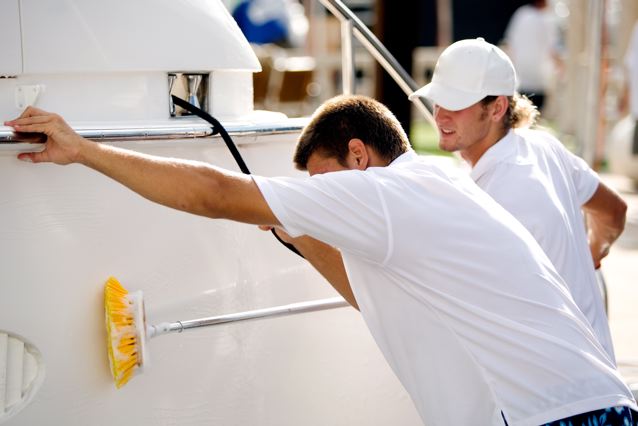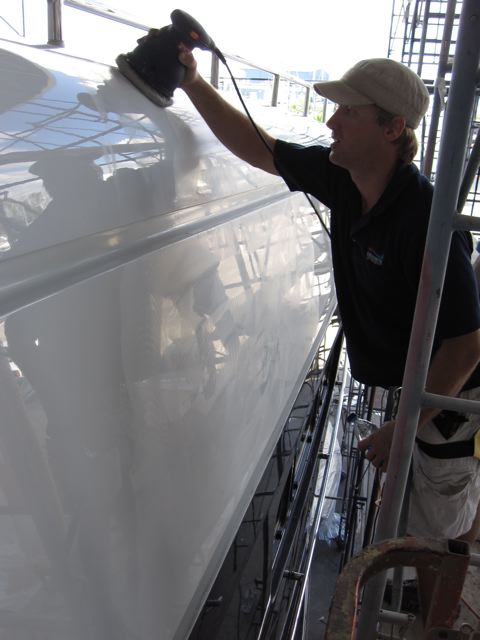With the turn of the new year ShowBoats has selected the finalists for its 2014 ShowBoats Design Awards…
All posts by Josh Cunningham
On July 1, 2010, Charlie Crist signed a piece of legislature that packed a much needed punch for the marine industry of South Florida. Freedom to own American was delivered…
Yacht owners have a broad selection of flags to choose from these days when it comes to a yacht’s flagship and registration. Many things must be taken into consideration before…
Got yacht crew? Touring in U.S waters? A great deal has been said ahead of the new MLC 2006 soon to be taking effect. However, the United States is yet to ratify the Maritime Labour…
For all those salt dogs out there. Test your true marine vocablary here…

What does class mean in reference to your yacht? It’s a powerful…
Does your head spins every time you go to West Marine or National Marine in search…
As summer’s calecent furry returns air conditioning units aboard yachts are usually running at a fast laborious clip. Often we’re called to a boat to investigate a musty smell brought on by these units not being ran on a regular basis often due to poor servicing. Running the A/C at consistant temperature through out your boat not only creates a suitable creature comfort temp but removes humidity from the vessel.
Mold and mildew thrive in humidity producing a sulfur (rotten egg smell) as a bi-product. This musty smell comes from restrictive air flow often as a result of crew failing to clean air filters located at the air handlers or raw water circulation strainers in the engine room. Many times these filters are hard to reach, hidden behind wooden shelfs or in tight compartments, gone unserviced this restricted, dirty air flow across the coils of the air handler prevents a stable balanced room cool down. 
Eliminate smell before it starts by applying these tried and true A/C preventative maintenance steps to your on board program.
Call or write us should you have any questions or concerns. We’re standing by to help you.
What good mother would send her child out into the blistering sun without sunscreen on? Alright babies and boats aren’t apples to apples but summer is here and there’s no better time than now to protect your vessel’s gel-coat and painted surfaces from the harsh weather elements that exist.
When a yachts gel-coat or painted surfaces are left unprotected deterioration quickly starts to take place at a micro-level causing the surface to becomes porous and rot. Shine is immediately taken away and the vessel’s gel-coat or paint begins to haze, taking on a flat color. The porosity of the surface catches more dirt preventing it from sliding off your boat thus requiring much more cleaning and work. The good news is almost all gel-coated surfaces and painted surfaces can be restored, given there is still dept and it hasn’t been worn through.

It’s imperative that the restoration and maintenance of your vessel’s cosmetics surfaces follow certain steps pertaining to products and application techniques. Having the wrong product or application method can cause swirl marks, waste time, heaps of money and or destroy your vessel’s paint job. Below are a few tips we’ve learned over the years having mastered this process.
Step #1-THOROUGH VESSEL WASH DOWN
Using an aggressive soap/cleaner give the yacht a thorough wash down and good chamois. This will guarantee a clean surface and keep dirt from clogging up your wool buffing bonnets.
Remember you want to remove dirt when polishing your boat not move dirt so make sure your brushes, pads and micro-fiber are always clean and fresh!!
Many time people think because they are compounding first or cutting off the top millimeter that it doesn’t make a difference to wash it.. it does and wool pads are expensive so give it a good wash first.
Step #2-COMPOUNDING, MICRO-FINISHING AND WAXING

If you’ve ever seen an old piece of wood being sanded down to a beautiful finish you know that the process requires several steps and usually starts with a rough sandpaper to remove the dead (grey) wood and then a medium grit sand paper to minimize the heavy scratches creating smoothness and then a light sandpaper to fully remove light scratches thus creating a friction less substrate before a polyurethane sealer is applied as a last step to protect the wood from the wind and rain.
The same principles apply when finishing gel coat and paint except our sand paper comes in the form of liquid compound laden with chunkier minerals for heavy (coarse) cut and lighter minerals for (lighter) cut. Our wax is usually a silicon polymer for pure protection.
To properly finish gel coat or painted surface you must start with the most aggressive grit compound needed to fully remove the dead surface and restore color and clarity after which (like finishing wood) you stage down moving to lighter compounds that will remove scratches and bring shine and clarity before applying a topcoat or wax to seal and protect the surface.
Most times this is a multi step process unless the boat’s gel coat or paint is brand new and or has been perfectly maintained and needs just a coat of protective wax.
The 1st cleaning compound used will depend on the amount of oxidization or fade your vessel’s surface has. A heavy haze (chalky look) will require a heavy cut compound, a medium haze (cloudy look) will require a medium cut compound and a light haze (misty looking) will require a light cut compound to restore to fresh paint and gel-coat look, shine and appearance. After which an application of topcoat or wax is applied to seal the surface and keep out the elements.
PRO ADVICE: For each step or type of compound used a different texture of buffing pad is needed-Heavy duty compound requires a white (course) wool buffing pad-Medium and light compound requires a yellow- (medium) texture wool buffing pad. Foam pads are HIGHLY recommended when finishing dark color yacht paint and are of different texture depending on color. Apply wax with hand orbital, remove by hand and polish at slow speed with a perfectly clean soft buffing pad.
NOTE: Use a spur (cleaning tool or rake stick) to clean your pads frequently when polishing as residue will build up and cause swirls and burn marks, when your pad has tight short dread locks it’s done**Product knowledge and application technique is what separates the pros from the bums**ohh yeah don’t exceed 3000 rpm on your machine and apply even steady pressure in 3 foot horizontal and vertical motions when buffing.
PRODUCTS: The 3m finishing system has been the leading paint and gel coat finishing system over the years. It flat out works! Presta products out of Miami deliver an excellent, comparable line of product that are water based (no fillers) and a bit cheaper.
Please commment to let us know what steps and products work best for you!
Antifouling and Bottom Painting
Optimal cruising performance is often a reflection of your vessels underside. Your boats bottom coat is the first line of defense against some harsh elements trying to consume it. Staying on top of this preventative maintenance chore is one of the most important ones you face. The smallest amount of growth underneath your boat will affect speed and performance and if not sealed properly will penetrate your hull’s gel-coat creating core rot (blisters).
Let’s find the right paint for you!
Favorable bottom coatings for your vessel should depend on what type of boating you do, where you boat and the type of bottom paint applied to your boat in the past. Fresh water boating doesn’t necessarily require the same strength and durability of bottom paint as say a fishing boat in the Florida Keys.
“Bottom paints act as a barrier to reduce marine growth and barnacles by releasing toxic biocides at a carefully controlled rate” Back in the day of old the bellies of boats were nailed tight with copper platting, now copper compounds (cuprous oxide) are laden in the bottom paint itself to combat growth some contain “slimacides” which greatly reduce the sun’s deterioration of paint along the water line by filtering out UV and blocking photosynthesis.
2 Types of Anti-fouling Bottom Paint
It’s important to remember the pros and cons of each type of bottom paint. Compatibility of one paint on top of another is critical. Generally speaking softer paints can be applied over harder paints but not visa versa
Modified Epoxies
Modified Epoxies deliver a hard durable finish but require yearly repainting. The higher the cooper content the more resistant it is to algae and growth. Keep in mind “the cheaper paint, the less copper and protection” I don’t recommend short changing price for durability and protection. The warmer the water and longer the boating season the higher the bottom growth and better protection you’ll need. Modified epoxies are popular because they are typically cheaper and can be painted over each other if the bottom has been sanded properly for a nice firm lock.
Ablatives
Ablative paints are softer semi-hard paints that flake off over time much like a bar of soap. Multiple coats the 1st time applied is recommended and is well worth it. Ablatives with boosted copolymers are very popular because they allow a vessel’s bottom to go 2 or 3 years sometimes with out needing to be repainted.
TIP: When applying multi coats of Ablative paint make the base coat a different color of paint than the successive layers. Perhaps RED and other layers Blue or Black. This will allow you to see when you are down to your base level.
WARNING: Do not paint a modified epoxy paint over an ablative paint with out removing it completely first by sanding! It will simply flake off and your money and protection will be lost.
Preperation is Critical! Let’s do it!
▪ Pressure Washing-Should the hull have growth remove thoroughly with a pressure washer using a mold release agent
▪ Sanding and Prep-Should older paint exist remove using a DA and 100 grit sandpaper taking the underside of your vessel down to fresh gel-coat. If any blisters exist (bubbles caused from water penetration) remove them using the interlux repair guide to achieve a perfect underside substrate for an impermeable layer called the Barrier Coat.
▪ Applying a Barrier Coat-A barrier coat is an impermeable layer of epoxy that you will apply between paint and hull so that water cannot be absorbed and blisters cannot form-much like a primer. After applying and dry time has exceeded lightly sand with 120 sandpaper to give a perfect texture for bottom paint to adhere.
Applying Bottom Paint.
Call Freedom Yacht Services today for the very best yacht detailing and protective coating experts




